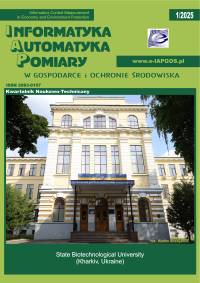MODUŁ SEROWANIA DLA IMPULSOWEGO SPEKTROMETRU NQR-FFT
Andriy Samila
asound@ukr.netYuriy Fedkovych Chernivtsi National University, Department of Radio Engineering and Information Security, Department of Solid State Physics (Ukraina)
Alexander Khandozhko
Yuriy Fedkovych Chernivtsi National University, Department of Radio Engineering and Information Security, Department of Solid State Physics (Ukraina)
Ivan Hryhorchak
Lviv Polytechnic National University, Department of Engineering, Materials Science and Applied Physics (Ukraina)
Leonid Politans’kyy
Yuriy Fedkovych Chernivtsi National University, Department of Radio Engineering and Information Security, Department of Solid State Physics (Ukraina)
Taras Kazemirskiy
Yuriy Fedkovych Chernivtsi National University, Department of Radio Engineering and Information Security, Department of Solid State Physics (Ukraina)
Abstrakt
W artykule opracowano funkcjonalne i algorytmiczne metody automatyzacji spektrometru NQR z szybką transformatą Fouriera do kontroli operacyjnej i nastawiania wszystkich koniecznych jego parametrów. Podstawą modułu sterowania spektrometrem jest układ PLD. Urządzenie jest wykonane w postaci struktury blokowej, która zawiera: płytę główną, wyświetlacz LCD, kontroler i porty wejścia-wyjścia. Przeprowadzono testy modułu w połączeniu z syntezatorem częstotliwości i układem formowania impulsówsekwencji radiospektrometru NQR. Wyniki testów pokazały, że funkcjonalne możliwości moduł odpowiadają wymaganiom, które są stawiane urządzeniom spektroskopii relaksacyjnej i impulsowo-rezonansowej.
Słowa kluczowe:
radiospektrometr, NQR, syntax modeling, struktury logiczne, symulacje, moduł sterowania, CPLDBibliografia
AL-Dhaher A. H. G.: Development of Microcontroller/FPGA-based systems. Int. J. Engng Ed., vol. 20, No 1, 2004, 52–60.
Google Scholar
Dot Matrix Liquid Crystal Display Controller/Driver (HD44780U), Hitachi, 1998.
Google Scholar
DS18B20 Programmable Resolution 1-Wire Digital Thermometer data sheet. Maxim integrated, USA.
Google Scholar
Itozaki H., Ota G.: Nuclear quadrupole resonance for explosive detection, International journal on smart sensing and intelligent systems, vol. 1, No 3, 2007, 705–715.
Google Scholar
Іvanets S. A., Zuban Y. О., Kasimir V. V., Litvinov V. V.: Proektuvannya komp'yuternyh system na osnovi mikroshem prohramovanoyi lohiky, monograph. Sumy, Ukraine: Sumy State University, 2013.
Google Scholar
Khandozhko A., Khandozhko V., Samila A.: A pulse coherent NQR spectrometer with effective transient suppression. Eastern-European journal of enterprise technologies, vol. 6, No 12(66), 2013, 21–25.
Google Scholar
Khandozhko V., Raranskii N., Balazjuk V., Kovalyuk Z., Samila A.: Temperature and baric dependence of nuclear quadruple resonance spectra in indium and gallium monoselenides. Eleventh International Conference on Correlation Optics, Proceedings of SPIE, Bellingham, WA, 2013, vol. 9066, 90661G-1–90661G-7.
Google Scholar
Marquina-Sanchez R., Kaufmann S., Ryschka M., Sattel T. F., Buzug T. M.: A Control Unit for a Magnetic Particle Spectrometer. Springer Proceedings in Physics Magnetic Particle Imaging, vol. 140, 2012, 309–312.
Google Scholar
MAX II Device Handbook (MAX®II EPM1270), Altera, 2009.
Google Scholar
Meyer-Baese U.: Digital Signal Processing with Field Programmable Gate Arrays, Third Edition. Originally published as a monograph. Berlin, Germany: Springer-Verlag Berlin Heidelberg, 2007.
Google Scholar
Politans’kyy L. F., Samila A. P., Khandozhko V. A.: Observation NQR in thermometric substance Cu2O. Sensor Electronics and Мicrosystem Technologies, vol. 10, No 4, 2013, 23–27.
Google Scholar
Pryschepa S. L., Ylyna E .A.: Proektyrovanye tsyfrovyh shem s pomoschyu SAPR MAX+PLUS II firmy Altera, Uchebno-metod. posobie. Minsk, Belarus: BGUIR, 2005.
Google Scholar
Samila A. P.: Development of digital frequency synthesizer PLD based for NQR pulse fourier spectrometer. Meždunarodnyj naučno-issledovatel'skij žurnal, vol. 12(19), 2013, 124–127.
Google Scholar
Schiano J. L.: Continuous wave nuclear quadrupole resonance spectrometer, United States Patent 2009/0039884 A1, Feb. 12, 2009.
Google Scholar
Steshenko V. B.: PLIS firmy ALTERA: proektirovanie ustroystv obrabotki signalov. Moscow, Russia: Dodeka, 2000.
Google Scholar
The ALTERA Measurable Advantage website: http://www.altera.com/
Google Scholar
Autorzy
Andriy Samilaasound@ukr.net
Yuriy Fedkovych Chernivtsi National University, Department of Radio Engineering and Information Security, Department of Solid State Physics Ukraina
Autorzy
Alexander KhandozhkoYuriy Fedkovych Chernivtsi National University, Department of Radio Engineering and Information Security, Department of Solid State Physics Ukraina
Autorzy
Ivan HryhorchakLviv Polytechnic National University, Department of Engineering, Materials Science and Applied Physics Ukraina
Autorzy
Leonid Politans’kyyYuriy Fedkovych Chernivtsi National University, Department of Radio Engineering and Information Security, Department of Solid State Physics Ukraina
Autorzy
Taras KazemirskiyYuriy Fedkovych Chernivtsi National University, Department of Radio Engineering and Information Security, Department of Solid State Physics Ukraina
Statystyki
Abstract views: 193PDF downloads: 61
Licencja

Utwór dostępny jest na licencji Creative Commons Uznanie autorstwa – Na tych samych warunkach 4.0 Miedzynarodowe.









